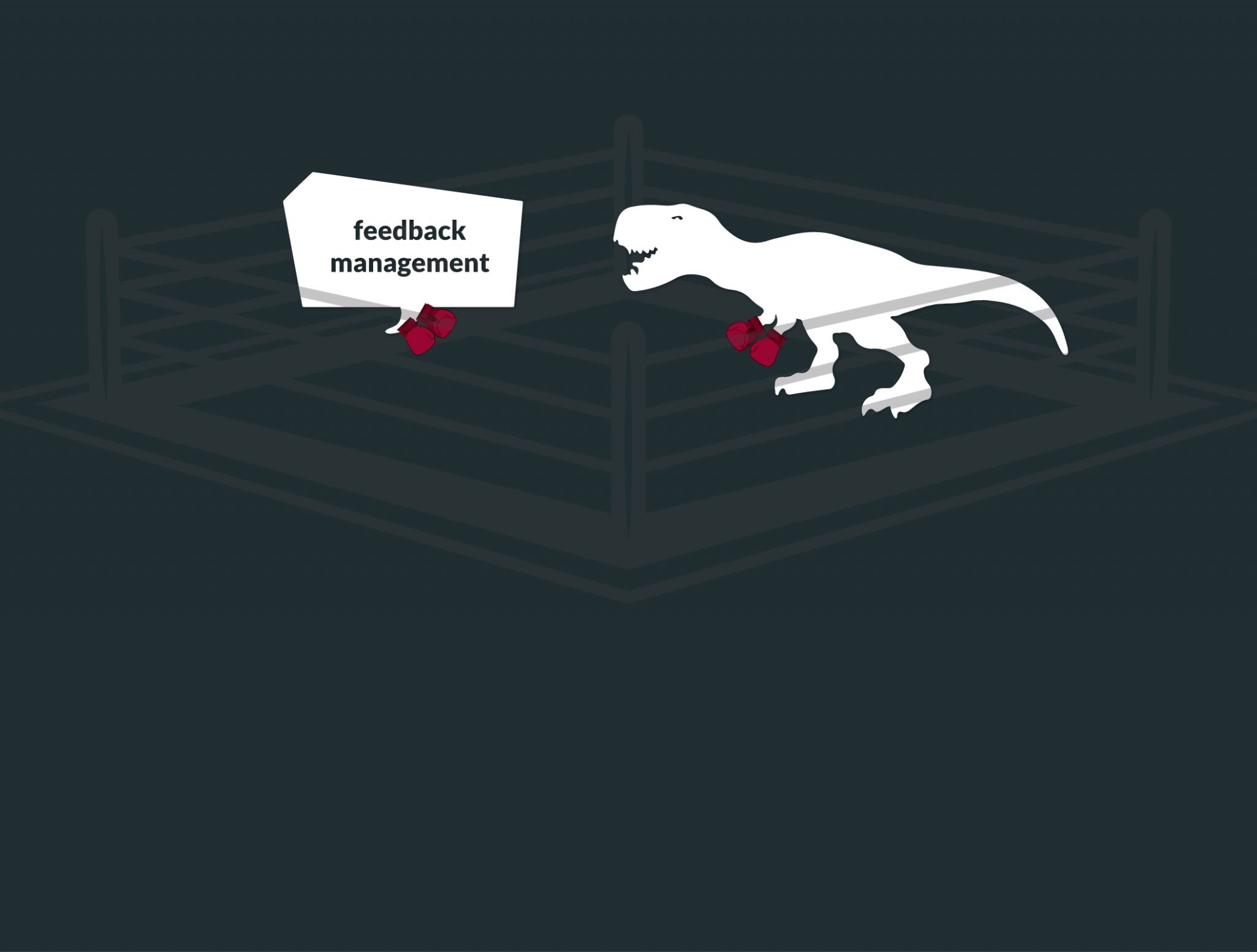









11 minutes reading time

“Where would we end up if employees were openly asked about their work environment and their bosses? That would just amount to negative anonymous feedback to the supervisor. We’d rather not do that…”
This, or something similar, is what you hear from time to time, especially at companies with many years of market experience. Alternatively, these companies prefer to be satisfied with filtered feedback that the employee is asked to provide – in the presence of the supervisor. The motto is: better an embellished feedback than an honest one.
But why is this the case? Why do otherwise innovative companies behave like prehistoric reptiles when it comes to feedback management? And is there perhaps another way of looking at the issue?
Could the establishment of feedback management possibly open up completely new possibilities for the company and even lead to a competitive advantage? We send the dinosaur into the boxing ring and get to the bottom of it.
Let’s get ready to ruuuuuumble.
Is fear the cause of many companies’ questionable disinterest in introducing a feedback culture? Do companies really not dare to solicit feedback from their employees for fear of reading employee displeasure in black and white on paper?
Or is this perhaps a matter of protecting superiors? Is it to keep the bosses, who are not used to criticism, safe and to spare their nerves? All too often, the danger of burnout is suddenly looming in the current climate. This should not be risked; after all, the expertise of the management elite is still needed.
After carefully weighing the pros and cons, one can only come to the conclusion that it would be better to postpone the survey to the distant future or to cancel it altogether. From a neutral point of view, this seems to be a safer option.
Meanwhile, in the boxing ring:
The bell rings. The first round begins. It starts right away. Both want to show that they are number one in the ring. This fight will determine who will take home the belt in the heavyweight division.
The Dino is in good shape and clearly dominates the first round. Feedback management a bit unusual, and much more than usual, in reverse. The Dino manages to land a hit and decides the first round in his favor.


But there is also fear and mistrust from the employee’s point of view:
“What if the survey isn’t anonymous after all? Then my boss will find out what I really think of him and I’ll have to suffer the consequences. I’d rather not take part in the survey at all.”
The second round is open. Feedback management is dangerous here and there, especially with his right hand, but he fails to land a hit. The Dino is the man in charge of the action in this round as well. It looks like Dino is on his way to asserting himself in this round as well.
Feedback management is having big problems, going on the defensive. Dino can’t miss a bit of a show. The referee separates the opponents. The second round also goes to the Dino.
But where does employee mistrust come from? And is soliciting employee feedback really the root of all evil? So is sneaking around it a good option? After all, you don’t want to conjure up any evil spirits.
Since the topic does seem to be somewhat fraught with conflict due to fears and concerns on both sides, and feedback management has easily stumbled in the ring, we take a closer look at the issue.
Would you like to learn more about employee surveys with easyfeedback?
“What if the survey isn’t anonymous after all? Then my boss will find out what I really think of him and I’ll have to suffer the consequences. I’d rather not take part in the survey at all.”
(Wikipedia )
Fear is part of our lives. It warns and protects us from danger. When we see ourselves exposed to danger, our body is immediately put on alert and the so-called fight-or-flight response kicks in.
The reason for this behavior lies in our tribal past. Fear and the reaction it triggers were simply necessary for us to survive. For example, it saved Fred Flintstone from going into the cave of the saber-toothed tiger and possibly being eaten by it.
Even in modern times, this mechanism still serves its purpose. But today the human being is rarely threatened by an acute danger to his life.
Okay, so what does this mean for our company?
So both employees and management are afraid of a possible threat. Employees are afraid of negative consequences for expressing an honest opinion, and supervisors are afraid of nagging employees who will do everything badly and, in the worst case, disrupt industrial peace.
So both parties choose the escape mechanism as a reaction to their fear. They prefer to avoid the unknown danger.
Our two opponents in the ring don’t have that option. Here, it’s still down to the wire. The Dino has a good jab. He is clearly the boss in the ring here. Feedback management stands there and waits, at least keeping his guard closed so as not to get hit full on.
“Keep the guard closed!” is also the announcement from the challenger’s corner. And of course that’s not a bad instruction, it’s the only way to avoid being dangerous for the dino. Another round in favor of the dino.






But is there really a serious threat to the company and employees at this point by conducting or participating in an employee survey – and I’m talking about a serious threat, you remember the saber-toothed tiger?
Probably not! Neither the existence of the company depends on the result of the survey, nor will the employee face an acute threat to life and limb from the disgruntled boss. Unless … No, probably not.
Okay, let’s hold on to what we know so far: Fear is not always our best advisor, and since we’ve clarified that there is probably no life-threatening situation that would make an escape response seem necessary, we can look at whether there are other possible reasons that might militate against soliciting employee feedback.



“Bosses unconsciously steer their communication behavior in that direction:
Let’s not have a fight in the team!”

Thank you Ms. Gstoettner, so this is about avoiding conflicts? Supervisors want to avoid unrest in their team, and employees don’t want to have to explain to their boss why they think they are incompetent. Both concerns offer enormous potential for conflict, so it’s hardly surprising that those involved would like to avoid it.
But anyone who has ever been in a relationship knows that it is only possible to a limited extent to permanently avoid conflict or sweep problems under the rug. Sooner or later, the bump under the carpet is clearly visible. Especially if you maintain daily contact. Our dinosaur should already know this from the Stone Age.
But does an employee survey really stir up so much dust that employees and bosses can no longer see each other, symbolically speaking? And shouldn’t the question then rather be: Where is all the dust coming from? And why the hell hasn’t anyone ever cleaned the place properly?

The basic building block for the acceptance of employee surveys is an open corporate culture. In our example, this is certainly present, albeit somewhat dusty.
The employees have apparently not been asked for their opinion for some time and are now confronted out of the blue with an “anonymous” questionnaire on which, in addition to personal opinion, departmental affiliation, age and gender are to be documented. They are right to be skeptical.
Why should the employee go along with this deal? Especially if another doubt is then added:
“Why should I fill this out? It won’t change anything anyway!”
The referee rings the bell for the new round.
Dino makes an aggressive entrance. He’s got a good jab coming through there. The left, twice. He’s got the better defense. If feedback management wants to get there, he’s got to hit a jab. At least something like a try with the right. But it’s not enough to win the round. The point goes to the dinosaur.
Time and again, employee surveys are conducted only pro forma, either to comply with corporate requirements or to be able to present company auditors with nicely designed documents that lack significant content.
The motto is: “We’ve done something, haven’t we? We take the opinions of our employees seriously.” But how credible is this statement if, after a survey, no changes are implemented or the issue is simply not addressed at all?
Probably not very credible from the employees’ point of view. Rather, this leads to resentment among the workforce and a lack of interest in further surveys, because they only cost employees time and do not bring them any added value.
So the following classic don’ts must be avoided:
Lack of anonymity/sham anonymity
No evaluation of the results
No feedback on the survey
No reaction after the survey
Going straight to the heart of the matter
Lack of employee involvement
Survey is only conducted once/too infrequently



If you avoid these points, you have already laid a solid foundation for establishing feedback management. But be careful: Don’t just barge in with the door – or a whole cleaning squad. To begin with, it is best to conduct surveys on innocuous topics, such as work equipment.
If the survey reveals, for example, that the cooks in the cafeteria urgently need new pans, then it’s time to get new pans. Or is there a constant lack of coffee in the coffee kitchen, then appointing a coffee officer would be a good way to fix this problem.
If something times is not directly implementable, then this should be openly communicated to the appropriate position. It is important that the employees realize that their suggestions are taken seriously and that something is changed for the better as a result of their suggestions.
Innocuous topics for a gentle introduction to feedback management might include:
Survey on required work tools
Survey on current processes (optimization)
consultation on new measures/ideas
Supplier evaluations

All these topics are not about individual employees and their personal performance. If surveys of this kind are carried out repeatedly, employees will eventually learn that nothing bad happens as a result of the survey.
On the contrary, they will notice that something positive comes out of the feedback given, and already the acceptance of employee surveys in the company increases. Positive conditioning takes place, which overrides the primarily existing fears.
The employee learns: If I point out possible problems, I will not be punished, but rewarded. The rewards are, for example, better work equipment, better workflows in day-to-day business, appreciation when contributing to changes or optimizations.
Employees are more satisfied and gradually gain confidence, which then allows difficult issues to be addressed.
Would you like to learn more about employee surveys with easyfeedback?
The new round is open in the boxing ring.
What happened during the break? Was there something in the feedback management’s drinking bottle? There was the right one suddenly on the chin of the dinosaur. He doesn’t do anything, he doesn’t hit back. He has to keep his guard up so he doesn’t get hit again.
The feedback management keeps his opponent at a distance with an outstretched arm by hitting his guard again and again. The dino stumbles back. Feedback management is back in the fight and wins the round. A terrific comeback. The fight is not yet decided. It remains exciting who will grab the belt here.
Transparency also adds great value to the success of an employee survey. It already makes sense to involve employees in the analysis of the survey and to communicate the results and comments openly – but of course anonymously.
In this way, each employee can become a problem solver and initiate improvements. It also gives everyone the chance to learn from others what is already going well.
Another option is to involve employees in corporate decisions. For example, it can make sense to obtain employee feedback before introducing a new product. By asking employees for their opinion, this creates stronger employee loyalty and identification with the company, and the dust is gradually removed.
But the company also benefits from employee feedback and can check how the product is received. If it doesn’t go down well with the employees, it probably won’t go down well with any customers either.
We have now been able to gradually reduce employees’ fears. But what happened to the fears of supervisors that employees would only use this platform to complain and vent their frustrations, or that conflicts would increase? Well, this fear cannot be completely ruled out.
You might hear statements like, “My boss is a lazy mouse-pusher who knows more about foosball than he does about managing employees,” or, “The pay at this club is sub-par.” Ok, that may not be nice, but taking it sportingly also helps the boss to develop personally.
Through the positive conditioning described earlier, employees become more satisfied and thus certainly have less to gripe about. And if they grumble like mountain goats, then it is a matter of listening to them and drawing starting points for improvement from the negative ballast.
On the one hand, this contributes significantly to a positive bond between employees and the company, and on the other hand, it leads to continuous improvement of the company.
The new round is rung in. Feedback management starts strong again, hitting Dino with an uppercut. At least the Dino’s cover work was reasonably solid. Again and again the lead hand.
The Dino has to take some punishment in this round. Fifteen seconds left and then this wonderful right to the chin of the Dino. The Dino manages to fight his way up off the ground once again. But the round goes to feedback management.
In the meantime, we’ve already been able to identify some fears and get them out of the way, but there’s still a doubt on the part of the company:
“So much work, and what’s it all for?”
Okay, it’s true. It takes a bit of work to establish a healthy feedback culture in a company. Open to-do’s here are: design the questionnaire, get the works council on board, motivate employees to participate, ensure anonymity, and and and.
A common mistake in practice is to conduct surveys only once a year in order to apparently save time. However, companies that act according to this principle usually do themselves no favors, because the survey is then so packed with questions – in order to cover all topics in one go – that the evaluation effort is considerably higher.
In addition, the analysis lacks adequate comparison options, since team constellations and the external and internal challenges may have changed within a year. The company therefore always starts from scratch, so to speak. This means that there is no longer any question of saving time.
It is therefore important to check whether it really always has to be the time-consuming full survey. For example, pulse surveys can be used for a short survey of the staff’s mood.
Pulse surveys make it possible to ask an easily digestible number of questions in short cycles. Focusing on a few topics or tackling one topic at a time can be worthwhile. This also keeps the workload in check.
A regular survey of employee sentiment makes changes visible more quickly. This gives the company the opportunity to respond quickly and make adjustments.
Employees who are asked for their opinion are also generally more satisfied and motivated. And that, in turn, can have a positive impact on creativity, productivity and innovation. In short: The company benefits from satisfied employees, also in the company figures – well, if that’s not an argument!?
Possible roadmap for establishing feedback management:
Solicit employee feedback on innocuous topics
Evaluate survey
Implement suggestions/eliminate problems
Repeat at regular intervals (e.g. pulse surveys)
➞ Subgoal: Increase acceptance among employees and the company

Let’s keep it simple: We have managed to gradually reduce the fears on the part of the employees by taking away their fear of a survey through positive conditioning.
And we actually managed to arouse the dinosaur’s interest by explaining to him the positive impact on the company’s success. With a few bills in front of his nose as a lure, he suddenly wasn’t so reluctant after all.
➞ Main objective: Increase employee satisfaction and company success.
By establishing a regular feedback culture, employee satisfaction will gradually increase noticeably. This is usually associated with several positive effects: Employees become more loyal to the company. This means that there will be less fluctuation within the company, so that costs for personnel recruitment can be saved.
The company becomes an even more attractive employer for potential applicants and can thus stand out from its competitors. Employee satisfaction also creates space and ideas and promotes future company development.
The goal should therefore be to establish open communication within the company, in which employees and supervisors are in a constant open exchange. After all, anonymous expression of opinions is merely an issue in companies where fear is still the predominant feeling rather than courage to work together on the company’s goals.
Work is also done in a boxing match. Feedback management clearly dominates the fight in this round as well. The dinosaur tries an attack. The feedback management nimbly dodges. There the Dino already runs into the right-left combination. He can’t stand there so openly.
This is the strongest, the most dominant round of feedback management. Again the uppercut, the dino lands on the ground. Can he get back up?
He tries to get to his feet. The referee counts Dino out. No, the fight is over. The end. A terrific performance. The feedback management may rightly call himself the number 1 in heavyweight boxing.



The dinosaur is probably pretty much finished after this fight. But feedback management is just at the beginning of its career. Not only in boxing, because feedback management is a continuous process. Even though our Dino lost this fight, some of his concerns were initially justified.
With a twinkle in our eye, we explored the fears, opportunities and possibilities of establishing a feedback culture within a fictional company.
Our dinosaur learned this lesson hard in a boxing match and had to take a few punches. Fortunately, you have the opportunity to approach the topic a little more gently and thus avoid setbacks. Nevertheless, you too will face hurdles that need to be overcome.
Feedback management is not a one-time project, but a continuous process. But it pays to keep at it. After all, it is not only the employees who benefit from open communication within the company, but also the company’s success in particular.
So sometimes it pays to face your fears. When will you face yours?